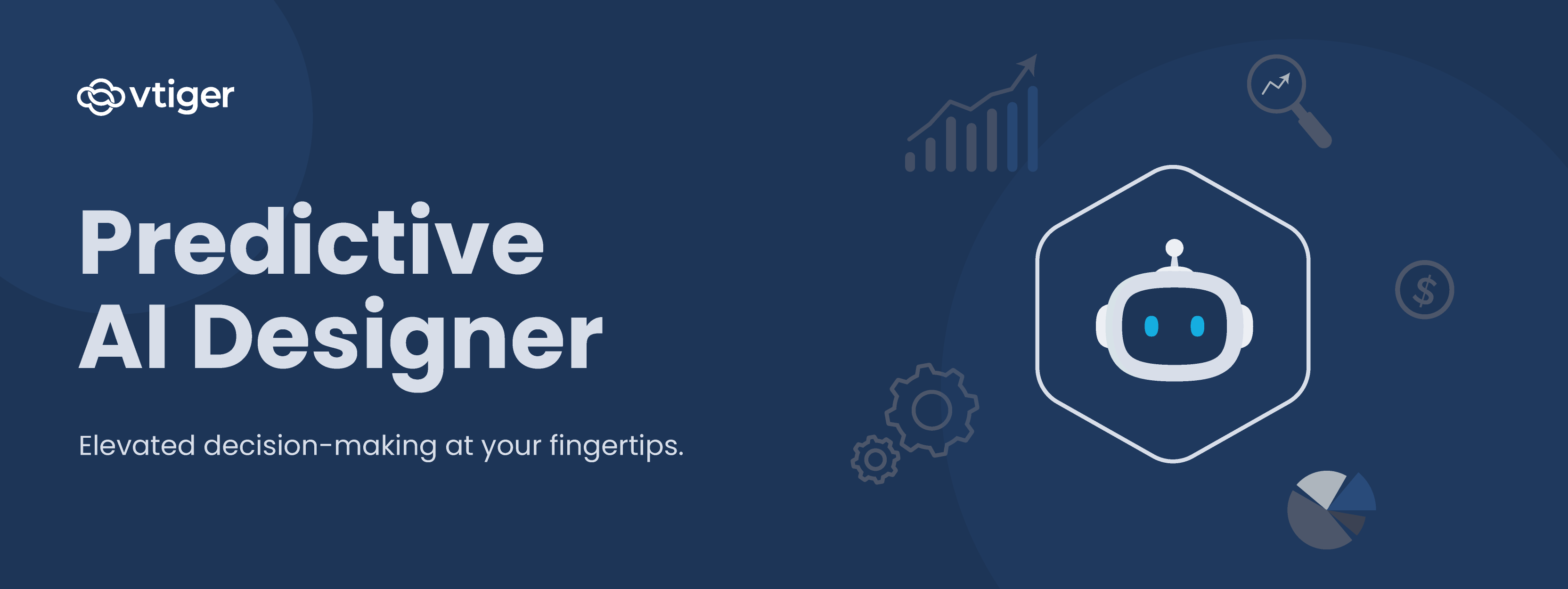Vtiger’s Predictive AI Designer is a powerful feature that enables businesses to analyze historical data within their CRM and forecast future outcomes. This tool allows you to create predictive models tailored to your specific needs.
By leveraging predictive AI, organizations can:
- Identify patterns in existing data.
- Empower sales and marketing teams to concentrate their efforts where they will have a significant impact.
- Enhance decision-making, drive operational efficiency, and support strategic planning for growth.
Types of Predictions
Predictions can generally be divided into two main types: Classification Prediction and Continuous Variable Prediction. Each type serves a different purpose and utilizes distinct methodologies.
- Classification Prediction
Classification Predictions are used to categorize data into predefined classes or labels. This type of prediction typically involves binary outcomes (Yes/No) or multiple classes. Here are some examples:
- Will the customer renew? (Yes/No)
- Will the invoice be paid on time? (Yes/No)
- Will the task be completed by the due date?
- Will the case be resolved within SLA time?
- Continuous Variable Prediction
Continuous Variable Predictions are about predicting a number with many different values. This approach is practical when the result isn’t just a set of specific categories but falls anywhere on a continuous scale. Here are some examples:
- Estimating when a particular task will be finished. (Date and Time)
- Determining the best person for a sales deal based on various metrics. (Scoring or Rating)
- Identifying the most suitable individual for handling a lead based on performance data. (Scoring or Rating)
Benefits of Using Predictive AI Designer
The Predictive AI Designer offers several advantages. It enhances your ability to create effective predictive models tailored to specific business needs. Here are the key benefits:
- User-Friendly Custom Models
- No Technical Expertise Required: You can build and train models without extensive technical knowledge, making them accessible to various business users.
- Quick Model Creation: The platform allows you to create custom models tailored to specific business requirements with just a few clicks. This is particularly useful for forecasting tasks such as lead conversion.
- Effective Parameter Selection and Training
- Tailored Training Process: You can select critical information from your CRM that influences predictions into your training processes. If you are forecasting task completion times, you can include parameters like task type, assigned member, etc., which will allow you to customize the model to your liking.
- Enhanced Contextual Relevance: You can create models that better reflect their operational realities by incorporating essential parameters.
- Versatile Prediction Types
- Adaptable Models: Predictive AI Designer supports various prediction types, including classification models for categorical predictions (e.g. identifying SLA violations) and regression models for continuous outcomes (e.g. predicting task completion dates).
- Custom Insights: Users can tailor insights to meet unique preferences, allowing for more relevant and actionable predictions.
- Improved Prediction Accuracy
- Outlier Detection: The system can identify and eliminate outliers—records that deviate significantly from norms (e.g., a task taking an unusually long time)—that can adversely affect model accuracy.
- Precision Enhancement: By removing these outliers, the overall precision of predictions is improved, leading to more reliable outcomes.
These benefits empower organizations to leverage predictive analytics effectively, enhancing decision-making processes and operational efficiency.
Use Case
Discovery Travels is a travel agency managing domestic and international travel programs. Managing inventory for tours and accommodations is difficult with several and often fluctuating booking patterns. This unpredictability created significant operational challenges, leading to two main issues:
- Overbooking: During popular travel periods, the agency sometimes overbooks tours and accommodations. This frustrated customers and damaged the agency’s reputation when it could not fulfill all bookings.
- Underutilization: Conversely, during off-peak times, the agency frequently needed more resources, such as empty hotel rooms or unfilled tour slots. This resulted in lost revenue opportunities and wasted resources.
The agency’s lack of insights into booking trends made it difficult to plan effectively, leading to inefficiencies and customer dissatisfaction.
How Predictive AI Designer Helped
To address these challenges, the travel agency implemented Vtiger’s Predictive AI Designer. They leveraged historical booking data and identified patterns in customer behavior. Here’s how it worked:
- Continuous Variable Predictions: The agency used continuous variable predictions to forecast future booking trends based on various factors such as:
- Historical booking data from previous years.
- Seasonal travel patterns.
- Special events or holidays that typically drive demand.
- Enhanced Inventory Management: By accurately predicting demand, the agency could adjust its inventory levels for tours and accommodations accordingly. For example:
- During high-demand periods, the agency could secure additional accommodations or expand tour capacities in anticipation of increased bookings.
- During off-peak times, the agency could offer promotions or discounts to encourage bookings and reduce underutilization.
- Improved Marketing Strategies: The insights gained from predictive analytics allowed the agency to tailor its marketing efforts more effectively. They could target specific customer segments with personalized offers based on predicted travel interests and behaviors.
Results
The implementation of the Predictive AI Designer led to several positive outcomes for the travel agency:
- Reduced Overbooking: By accurately forecasting demand, the agency minimized instances of overbooking, leading to improved customer satisfaction and loyalty.
- Increased Revenue: With better inventory management during off-peak seasons, the agency capitalized on opportunities to fill vacant slots, thereby increasing overall revenue.
- Operational Efficiency: The ability to anticipate demand allowed for more efficient resource allocation, ensuring that both staff and inventory were optimally utilized.
In conclusion, Vtiger’s Predictive AI Designer revolutionizes decision-making for businesses by providing data-driven insights that enable proactive management rather than reactive responses. By predicting customer behaviors, sales outcomes, and operational efficiencies, it empowers users to make informed decisions that shape their business futures. This innovative tool allows organizations to identify high-converting leads, optimize team assignments, and enhance customer satisfaction, ultimately transforming decision-making into a proactive strategy that mitigates risks and capitalizes on opportunities for growth.
Get to know even more about Predictive AI Designer right here!



